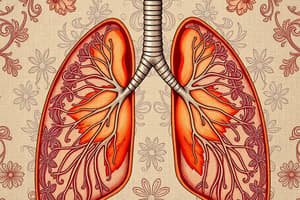Podcast
Questions and Answers
What is the primary mechanism that drives air into the lungs during ventilation?
What is the primary mechanism that drives air into the lungs during ventilation?
The diaphragm and rib cage moving to decrease air pressure in the lungs causing air to rush in.
If a person has a damaged diaphragm, how would this affect their breathing?
If a person has a damaged diaphragm, how would this affect their breathing?
The person would have difficulty breathing because the diaphragm plays a key role in inhalation.
Explain why breathing is considered a passive process.
Explain why breathing is considered a passive process.
Breathing is passive because it results from naturally occurring pressure changes in the lungs.
Describe the roles of the diaphragm and intercostal muscles in the process of inhalation.
Describe the roles of the diaphragm and intercostal muscles in the process of inhalation.
How does the air pressure inside the lungs compare to the air pressure outside the body during inhalation, and why is this difference important?
How does the air pressure inside the lungs compare to the air pressure outside the body during inhalation, and why is this difference important?
During ventilation, air moves into and out of the lungs, reaching the exchange surfaces of the ______.
During ventilation, air moves into and out of the lungs, reaching the exchange surfaces of the ______.
The process of air moving into and out of the lungs is known as ______.
The process of air moving into and out of the lungs is known as ______.
For air to rush into the lungs, the pressure in the lungs must be ______ than the air pressure outside the body.
For air to rush into the lungs, the pressure in the lungs must be ______ than the air pressure outside the body.
The ______ is considered the most important muscle used during normal inhalation.
The ______ is considered the most important muscle used during normal inhalation.
Breathing is a ______ process that occurs due to changes in pressure within the lungs.
Breathing is a ______ process that occurs due to changes in pressure within the lungs.
Flashcards
Ventilation
Ventilation
The process of moving air into and out of the lungs.
Diaphragm
Diaphragm
A sheet of muscle below the lungs that contracts to create a vacuum, pulling air in.
Rib cage
Rib cage
They expand and contract, aiding in breathing.
Inhale
Inhale
Signup and view all the flashcards
Intercostal muscles
Intercostal muscles
Signup and view all the flashcards
What is ventilation?
What is ventilation?
Signup and view all the flashcards
Pressure and Breathing
Pressure and Breathing
Signup and view all the flashcards
Diaphragm's role
Diaphragm's role
Signup and view all the flashcards
Breathing process
Breathing process
Signup and view all the flashcards
Study Notes
- Ventilation involves air movement into and out of the lungs, facilitating gas exchange in the alveoli
- Air flows into the lungs when the diaphragm and rib cage movements create lower air pressure inside the lungs compared to the outside air
- The diaphragm is the primary muscle used during normal inhalation
- The external intercostal muscles serve as the second most important muscles in breathing
- Breathing is typically a passive process, resulting from pressure changes within the lungs
Studying That Suits You
Use AI to generate personalized quizzes and flashcards to suit your learning preferences.




